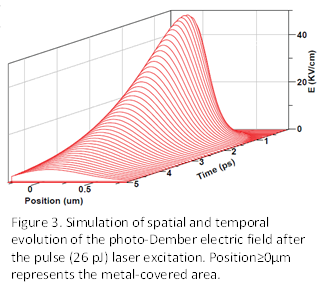58th Annual Report on Research 2013 Under Sponsorship of the ACS Petroleum Research Fund
Reports: DNI1051115-DNI10: Fundamental Investigation of Carrier Multiplication Processes in Carbon Nanomaterials
Zhaohui Zhong, PhD, University of Michigan
Progress Report:
The overall goal of the proposed project is to systematically study the fundamental exciton and carrier dynamics in carbon nanomaterials such as graphene. During the first year of the project, we built a scanning photocurrent measurement setup integrated with both continuous wave (CW) and femtosecond pulse laser as excitation sources, and discovered direct evidence of nonequilibrium hot carrier extraction from graphene. For the second year, we studied the mechanism for the hot carrier extraction at graphene/metal junction through photocurrent spectroscopy, and observed the formation of intense lateral photo-Dember field when exciting graphene-metal interface with femtosecond laser for the first time. The fund from ACS Petroleum Research Fund not only provides direct support to 3 graduate students for the past two years, but also greatly enhances PI's research strength in the area of carbon nanophotonics.
The photo-Dember effect is a transient dipole radiation process. The most common experiment is to excite a freestanding bulk GaAs or InAs with the femtosecond laser (Fig. 1a). Due to inhomogeneous light absorption and inherently mobility asymmetry, excited hot electrons and holes will diffuse from the surface toward inside with different velocities. This spatial charge separation builds up a transient photo-Dember field, inducing the subsequent dipole radiation perpendicular to the excited surface. In graphene, the same physical picture in bulk semiconductors could not be applied, since photocarriers cannot diffuse out of the graphene plane to build up charge gradient, and importantly, the distinction between electron and hole mobility is insignificant. Despite these intrinsic inhibitions, we predict the possibility of creating lateral photo-Dember field when exciting the graphene-metal interface with femtosecond laser. This can be understood via Fig. 1b in combination with the following key properties. First, partially incident light shadowed by the metal establishes a strong photocarrier gradient near the metal edge. This sharp gradient together with 2D spatial confinement causes the efficient diffusion of hot carriers into the lateral metal-covered area. Second, low electronic specific heat in graphene favors high carrier temperature after excitation. This combined with high carrier mobility will enhance the diffusion speed of hot carriers. Third, strong light coupling within the single atomic layer results in ultrahigh photocarrier density in graphene, which could be 1-3 orders higher than other low band gap materials. Importantly, this property will enhance photocarrier gradient and the ensuing diffusion process. Taken all together, the dynamics of nonequilibrium hot carriers could induce strong lateral photo-Dember field, which can also lead to extraction of hot carriers in graphene.
To confirm the formation of lateral photo-Dember field, we fabricated three back-gated graphene devices with different electron-hole mobility asymmetry. Device A and C have higher hole mobility than electron mobility, while device B shows higher electron mobility. Also, both device A and B are contacted with titanium and device C is contacted with Palladium. We then focused on the photoresponse of these three devices under femtosecond laser excitation. Fig. 2a-c are gate-dependent photocurrent maps measured from device A, B and C respectively. By comparing these maps, we not only observed photocurrent generation near the contact edge (position=0 and 5 um) but also observed three key features. First, gate-dependent photocurrent does not show polarity reversal. Second, the polarity of photocurrent from device B is completely opposite to device A and C. Third, regardless of the polarity of photocurrent, the magnitude of photocurrent peaks near the graphene Dirac gate voltage, and decreases by increasing doping concentration. Notably, this unusual photoresponse provides the evidence of creating ultrafast photo-Dember field. For the device A and C, photoexcited hot holes diffuse faster than hot electrons into the metal-covered area due to higher hole mobility of the device, building up a transient photo-Dember field and lead to electron collection at the metal contact. In contrast, hole carriers will be collected at the contact due to higher electron mobility of the device B. Regardless of the contact metal and doping concentration of graphene, the polarity of photocurrent is decided by the electron-hole mobility, providing a clear evidence for the formation of lateral photo-Dember field. Moreover, when the photo-Dember field is responsible for hot carrier extraction, the amplitude of photocurrent should increase with the hot carrier lifetime. This is not only because duration of the transient field increases with the lifetime, but also keeping excited carriers at the hot state is central to create a spatial charge distribution, giving rise to a strong transient field.
We further simulate the dynamics of hot carriers and photo-Dember field after the pulse laser excitation by using the drift-diffusion equations. As shown in Figure 3, the asymmetric hot carrier distribution near the vicinity of contact builds up a strong photo-Dember field. Furthermore, our model predicts increasing the asymmetry of electron-hole mobility as well as device mobility will enhance the field. The strength of field increases super-linearly with the pulse energy, originating from higher photocarrier density, gradient, temperature, gether with higher diffusion coefficient by increasing the pulse energy.
Our finding not only reveals that the mechanism of hot carrier extraction at the graphene/metal junciton is due to strong lateral photo-Demer effect, but also paves the way for graphene based new terahertz applications. We are preaparing a manuscript for publication at this time.
Copyright © 2014 American Chemical Society














